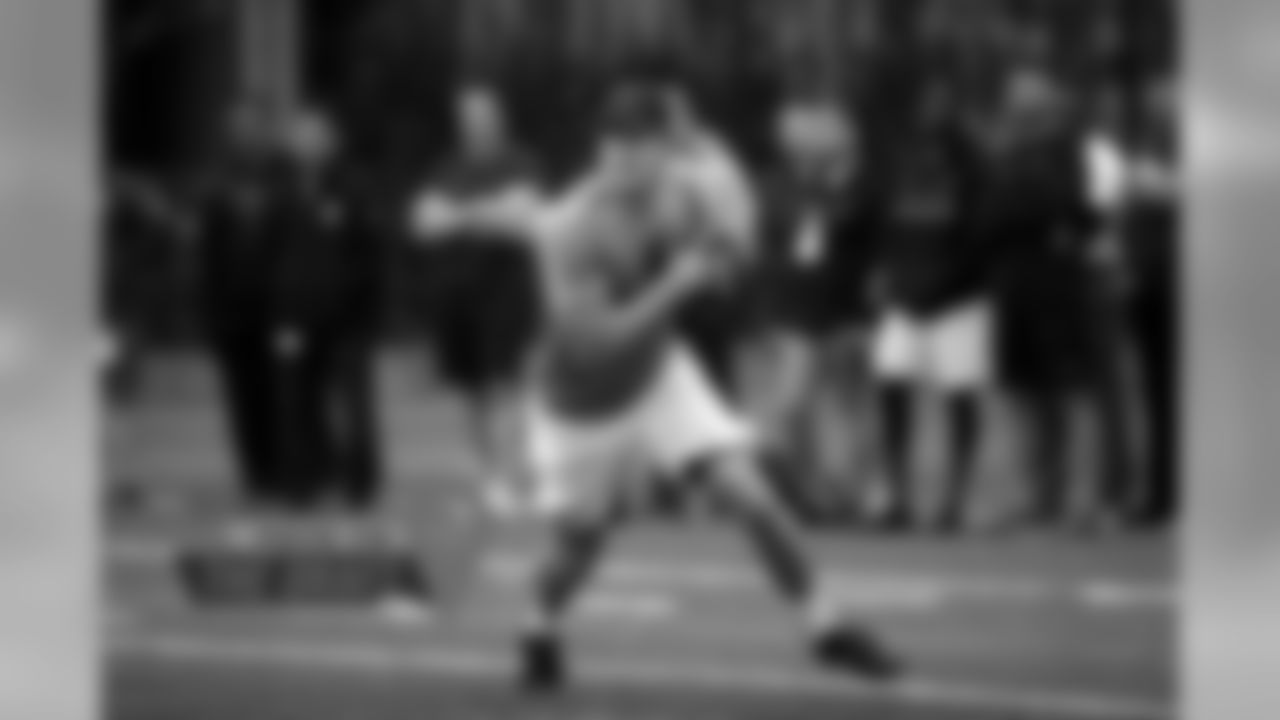In all likelihood, only one offensive lineman in this year's draft class could possibly end up selected in the first five picks. That the lineman happens to play guard makes this possibility one of the most fascinating of this season.
Notre Dame's Quenton Nelson could be the most talented player at his position in this year's draft class, and is arguably the best guard prospect in the last 30 years.
But he's fighting headwinds in the form of decades of trends.
Simply put, guards are rarely drafted in the top 10 in the modern NFL, let alone the top 5. In the 51 years of the modern NFL Draft -- since the AFL and NFL had their first common draft in 1967 -- just 16 guards have been picked in the first 10 picks, with only five of them going in the first five selections.
What is interesting is the variance among guards drafted in the first 10 picks. Three of the 16 became Hall of Famers -- an astounding 18.5 pecent Hall of Fame rate, even accounting for the small sample size -- and another two became a two-time All-Pro selection (Bill Fralic, No. 2 overall by Atlanta, 1985) and 2015 No. 5 overall pick Brandon Scherff of the Redskins.
So while just 31.3 percent of the pure guards taken in the first 10 picks became Pro Bowl selections, 53.6 percent of those taken in the next 10 selections were Pro Bowlers, including eight All-Pros -- which, at 28.6 percent, is higher than the percentage of All-Pros from the first 10 picks (25.0 percent).
Since 1990, the sweet spot for finding elite guards has come from pick 11 to pick 20. Although teams picked just 11 guards in that range in the last 28 drafts, seven of them were Pro Bowlers -- all earning multiple selections -- and four were first-team All-Pro selections.
Two other factors contribute to the lack of guards at the top of the draft. One is the ability to find solid starters at the position in the middle rounds. According to pro-football-reference.com, the average guard selected in the first 32 picks since 1990 is a full-time starter for 5.6 seasons, but that figure only drops to 3.9 seasons for players taken in what would be this year's second round (33-64) and 3.3 for those in current third-round slots (65-100). That is a marked contrast from quarterback, where second-rounders start for an average of 2.3 years, and third-rounders for 1.2.
Even for Day 3 guards -- Rounds 4 through 7 -- the average pick from each round is a starter for at least 1.3 seasons. The average guard taken in picks that correspond to this year's seventh round is a primary starter for 1.3 years -- 0.4 years more than the average quarterback taken for picks that cover this year's final five rounds.
The other factor is a simple question: How much better can an elite guard make your team?
Just six pure first-round guards from the common-draft era are in the Pro Football Hall of Fame. Three of them were top-10 choices: John Hannah (New England, No. 4, 1973), Mike Munchak (Houston Oilers, No. 8, 1982) and Bruce Matthews, Houston Oilers, No. 9, 1983). Matthews would play his career all over the line of the Oilers -- and later the Tennessee Titans -- but was drafted as a guard and spent most of his career there.
Gene Upshaw (Oakland, No. 17, 1967), Randall McDaniel (Minnesota, No. 19, 1988) and Joe DeLamielleure (Buffalo, No. 26, 1973) round out the list.
Among that group, only Upshaw won a Super Bowl. Matthews and Hannah each played in one. But four of the six -- Hannah, Munchak, Matthews and DeLamielleure -- all played on at least one team that won two or fewer games in a full, non-strike season.
Of the potential top 10 picks in this year's draft, Nelson likely offers the least risk of being a bust. The valid expectation of Nelson is that he could have a career like Munchak, Matthews, Upshaw, Hannah, McDaniel or DeLamielleure -- a career that sees long stretches of individual dominance and ends with enshrinement.
But Joe Thomas, an offensive tackle for the Browns who just retired, also dominated for the last decade. He never played in a playoff game -- and he played at left tackle, historically the position that attracts a premium draft investment -- and, later on, a premium cost in free agency. That was demonstrated this year by Nate Solder receiving a four-year contract from the Giants that could be worth up to $62 million.
Nelson could provide a team stability and potentially excellent form at a guard spot for the next decade. But the nature of his position ensures that he cannot elevate a team individually in the way that, for example, a quarterback could. So to take Nelson early and ensure a maximum return on investment, a team likely has to have its premium positions -- quarterback, left tackle, primary edge rusher and No. 1 cornerback -- secured with quality players.
Thus, the notion of Nelson as a top-5 pick isn't for every team. But if a team picking early believes it is set at those key positions, he could be worth the call.
MORE WHY THE BRONCOS SHOULD ...
- April 10: Pick a quarterback at No. 5
- April 12: Pick a defensive lineman at No. 5
- April 18: Pick a running back at No. 5
- April 20: Trade down from the No. 5 pick
After the 2018 NFL Scouting Combine, some of the top prospects participated in follow-up workouts at their college facilities to further show their talents.

Southern California quarterback Sam Darnold pulls back to throw a pass during USC Pro Day, Wednesday, March 21, 2018, in Los Angeles. Pro day is intended to showcase talent to NFL scouts for the upcoming draft. (AP Photo/Jae C. Hong)

Oklahoma quarterback Baker Mayfield passes during a drill at an NCAA college football Pro Day workout in Norman, Okla., Wednesday, March 14, 2018. (AP Photo/Sue Ogrocki)

UCLA quarterback Josh Rosen rolls out during UCLA's pro day for NFL draft prospects in Los Angeles, Thursday, March 15, 2018. (AP Photo/Michael Owen Baker)

Southern California quarterback Sam Darnold throws a pass during USC Pro Day, Wednesday, March 21, 2018, in Los Angeles. The Pro Day is intended to showcase talent to NFL scouts for the upcoming draft. (AP Photo/Jae C. Hong)

Penn State running back Saquon Barkley, right, talks with Marcus Allen between drills during Penn State Pro Day in State College, Pa., Tuesday, March 20, 2018. Barkley did not participate in drills. (AP Photo/Gene J. Puskar)

Oklahoma quarterback Baker Mayfield is surrounded by the media following an NCAA college football Pro Day workout in Norman, Okla., Wednesday, March 14, 2018. (AP Photo/Sue Ogrocki)

Alabama's defensive back Minkah Fitzpatrick, left, quarterback Jalen Hurts, center, and Pittsburgh Steelers head coach Mike Tomlin watch during Alabama's Pro Day, Wednesday, March 7, 2018, in Tuscaloosa, Ala. The event is to showcase players for the upcoming NFL football draft. (AP Photo/Brynn Anderson)

Penn State running back Saquon Barkley, tosses a football during Penn State Pro Day in State College, Pa., Tuesday, March 20, 2018. Barkley did not participate in the drills. (AP Photo/Gene J. Puskar)

UCLA quarterback Josh Rosen participates in drills during UCLA's pro day for NFL football draft prospects in Los Angeles, Thursday, March 15, 2018. (AP Photo/Michael Owen Baker)

Southern California quarterback Sam Darnold throws a pass during USC Pro Day, Wednesday, March 21, 2018, in Los Angeles. The Pro Day is intended to showcase talent to NFL scouts for the upcoming draft. (AP Photo/Jae C. Hong)

Penn State running back Saquon Barkley (26) catches a football during Penn State Pro Day in State College, Pa., Tuesday, March 20, 2018. (AP Photo/Gene J. Puskar)

Southern California running back Ronald Jones runs on the field during USC Pro Day, Wednesday, March 21, 2018, in Los Angeles. The Pro Day is intended to showcase talent to NFL scouts for the upcoming draft. (AP Photo/Jae C. Hong)

UCLA quarterback Josh Rosen passes during UCLA's pro day for NFL draft prospects in Los Angeles, Thursday, March 15, 2018. (AP Photo/Michael Owen Baker)

Southern California running back Ronald Jones runs on the field during USC Pro Day, Wednesday, March 21, 2018, in Los Angeles. The Pro Day is intended to showcase talent to NFL scouts for the upcoming draft. (AP Photo/Jae C. Hong)

Penn State running back Saquon Barkley (26) is surrounded by media while being interviewed during Penn State Pro Day in State College, Pa., Tuesday, March 20, 2018. Barkley did not participate in drills. (AP Photo/Gene J. Puskar)














